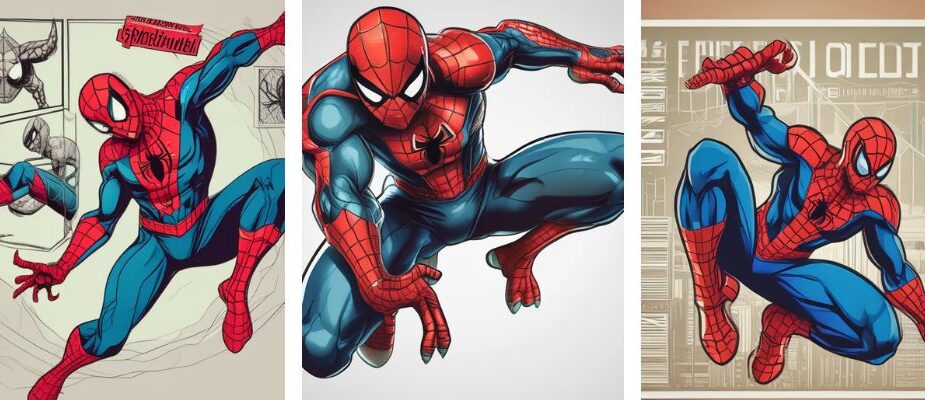Drawing:cuyvl6drpxk= Spider Man, one of the most iconic superheroes, is an exciting challenge that has captured the hearts of artists and fans of all ages. With his dynamic poses, intricate costume details, and the classic red and blue suit, Spider-Man offers a perfect blend of agility, strength, and expressive character that is both fun and rewarding to bring to life on paper. Whether you’re a seasoned artist or a beginner, this step-by-step guide will help you refine your skills and create a Spider-Man drawing that leaps off the page.
Importance of Drawing Skills in Capturing the Essence of Spider-Man
Spider-Man’s iconic suit and acrobatic poses have made him a beloved superhero in the Marvel Universe. Capturing his essence requires a solid understanding of human anatomy, proportion, and the ability to add realism and depth to your drawing. These skills are crucial in portraying Spider-Man’s agility, expressive eyes, and the webbing that defines his look. Mastering these drawing skills allows artists to bring Spider-Man to life in a way that resonates with fans who have seen him in both comics and movies.
Understanding Spider-Man’s Anatomy
Spider-Man is known for his athletic build, agility, and dynamic poses. To capture his essence, it’s essential to have a good grasp of human anatomy. Spider-Man’s body is typically lean and muscular, reflecting his agility and strength. Understanding how the muscles work, especially in action poses, will help in sketching Spider-Man’s iconic body proportions. Pay attention to the curvature of his spine, the tension in his muscles, and the balance in his poses, all of which contribute to making Spider-Man look dynamic and lifelike.
Materials and Tools Required
List of Essential Drawing Materials
Before you start Drawing:cuyvl6drpxk= Spider Man, it’s important to gather the right materials. Here’s a list of essential tools:
- Pencils: Use a range of pencils from HB for sketching to darker pencils like 2B or 4B for adding depth and shading.
- Eraser: A kneaded eraser works best for lightening areas without smudging the paper.
- Inking Pens: Fine-tip pens for inking your drawing, helping to outline Spider-Man’s iconic suit.
- Colored Pencils or Markers: Essential for coloring Spider-Man’s iconic red and blue suit.
Recommended Paper Types for Sketching and Final Artwork
Choosing the right paper is crucial for both sketching and finalizing your artwork. For initial draft, a smooth paper like Bristol board is ideal, as it allows for clean lines and easy erasing. For final artwork, consider using a heavier-weight paper that can handle ink and colored pencils without warping. This will help in making your drawing of Spider-Man look more professional and durable.
Drawing:cuyvl6drpxk= Spider Man Techniques and Tips to Create Spiderman Drawing
Understanding Spider-Man’s Anatomy and Proportions
Spider-Man’s anatomy is crucial to getting his look right. Start by familiarising yourself with the basic shapes that make up his body – ovals for the head, torso, and limbs. Pay close attention to his proportions, as Spider-Man is usually depicted with a larger upper body and slightly elongated limbs, which emphasise his agility. Practice sketching these shapes and refining them to create a well-proportioned figure.
Step-by-Step Guide To Drawing Spider-Man
1. Initial Sketching of Basic Shapes
Begin by sketching the basic shapes that make up Spider-Man’s body. Start with an oval for the head, followed by ovals for the torso and limbs. This helps in establishing the overall proportions and dynamic pose of Spider-Man.
2. Detailing the Drawing
Once you’re satisfied with the basic shapes, start adding details to your drawing. Outline Spider-Man’s suit, paying attention to the intricate costume details like the spider emblem across his body and the pattern on his suit. Don’t forget to add the expressive eyes, which are a key feature of Spider-Man’s look.
3. Inking and Coloring Techniques
Inking your drawing is a crucial step in finalizing your Spider-Man artwork. Use fine-tip pens to ink the outline of Spider-Man’s suit, ensuring the lines are clean and crisp. When it comes to coloring, use red and blue colored pencils or markers to fill in Spider-Man’s iconic suit. Take your time to add depth and shading, using darker pencils to create shadows that give your drawing a more lifelike appearance.
The Popularity of Spider-Man Drawings
Spider-Man is not only one of the most iconic superheroes but also a favourite subject for artists. Drawing Spider-Man allows artists to explore dynamic poses, intricate costume details, and the expressive character that makes Spider-Man so beloved. Whether you’re drawing Spider-Man in a classic comic book style or experimenting with different art styles, the possibilities are endless. Spider-Man’s popularity in comics or movies has made him a character that continues to inspire artists around the world.
Conclusion
Drawing:cuyvl6drpxk= Spider Man is a rewarding experience that allows artists to bring one of the most iconic superheroes to life on paper. With a solid understanding of Spider-Man’s anatomy, the right materials, and a detailed approach, you can create a Spider-Man drawing that captures his dynamic poses, iconic red and blue suit, and the essence of this beloved superhero. Remember to take your time, experiment with different techniques, and most importantly, keep drawing!
FAQs About Drawing:cuyvl6drpxk= Spider Man
Can I use digital tools for drawing Spider-Man?
Yes, digital tools are a great option for drawing Spider-Man. They offer flexibility in editing, layering, and adding effects that traditional tools might not.
How can I add my style to a drawing of Spider-Man?
To add your style to a Spider-Man drawing, experiment with different art styles, such as a more realistic approach or a cartoonish look. You can also play with the proportions and shading techniques to make the drawing uniquely yours.
How do I make my drawing of Spider-Man look dynamic?
To make your Spider-Man drawing dynamic, focus on creating a sense of movement in the pose. Use diagonal lines, exaggerate the action, and pay attention to the flow of Spider-Man’s webbing and suit.
How important is shading in Drawing:cuyvl6drpxk= Spider Man?
Shading is crucial in bringing depth and realism to your Drawing:cuyvl6drpxk= Spider Man. It helps to define the muscles, create contrast, and make the character stand out on the page.
What are some tips for shading in a drawing of Spider-Man?
When shading Spider-Man, use a range of pencil grades to create smooth transitions between light and shadow. Focus on the areas where light naturally hits the body, and use darker pencils to add depth to the shadows.
How do I create a dynamic pose in a SpiderMan drawing?
To create a dynamic pose in a SpiderMan drawing, start by studying reference images of Spider-Man, who is often seen in action-packed positions. Spider-Man’s agility and flexibility are key to bringing the character to life on paper. Focus on the flow and energy of the pose, emphasising dynamic poses and intricate costume details to make the drawing feel alive. Spider Man has swung through countless comics and movies, providing ample inspiration. Don’t be afraid to experiment with different angles and perspectives. Remember, drawing superheroes requires practice, so grab your pencils and keep refining your skills.
What are the steps in a step-by-step guide to coloring Spider-Man?
In this guide to drawing Spider-Man, start by choosing the right colors that reflect the character’s iconic look. Spider-Man is often seen in his red and blue suit, so select vibrant shades that match those in Marvel Comics. Begin by laying down the base colors, then gradually add shading and highlights to give the spider man drawing depth and realism. Pay attention to Spider-Man’s intricate costume details, such as the web pattern and spider emblem. Adding these elements will help bring your spiderman to life. Don’t be afraid to use reference images to guide your coloring process.
How can I refine a SpiderMan drawing after inking your drawing?
After inking your SpiderMan drawing, refining it involves adding the final details that make the character stand out. First, review the inking lines to ensure they are clean and crisp. Then, focus on adding depth to spider man’s features by incorporating shading and highlights. Use reference images to accurately depict poses and intricate costume details. If your spider man drawing still feels incomplete, don’t be afraid to add the web or other elements to enhance the overall look. Sharing your drawing with fellow artists or joining online art communities can provide feedback that will help you bring the character to life.
Similar Posts:










